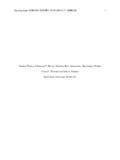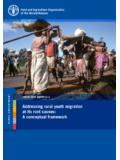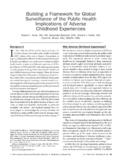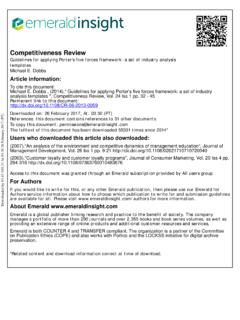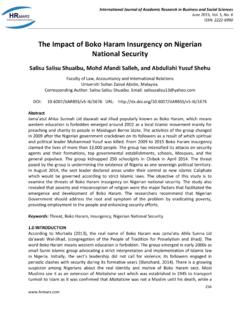Transcription of Nurse Retention Cheryl Howard Ferris State University
1 Running head: Nurse Retention 1 Nurse Retention Cheryl Howard Ferris State UniversityNURSE Retention 2 Abstract Nursing shortage and turnover affects the quality and safety of patient care, Nurse work environments and the operations of health care organizations. This paper outlines research collected about nursing shortage, Nurse turnover and Nurse Retention in order to explore the topic and provide evidence based recommendations for nursing Retention . Topics at hand are defined. Interdisciplinary theories relating to Nurse Retention are explained including the Nueman Systems Model in nursing and Kanter s Empowerment Theory in management. An assessment of the health care environment is fully explored including statistics, systems framework, policies, assumptions and quality and safety issues. A brief synopsis of the past, present and future of the nursing shortage is included as part of the health care environment assessment.
2 A root cause analysis is outlined including the problem, causes and recommendations. Inferences, implications and consequences are related to standards and competencies from the ANA and QSEN. Opposing viewpoints are also offered. The conclusion of this paper is that health care organizations should focus on Nurse Retention strategies by improving Nurse job satisfaction and addressing the nursing shortage in order to focus on the ultimate goal of patient quality and safety. Keywords: Nurse turnover, Retention , shortage, quality, safety Nurse Retention 3 Nurse Retention The issue of Nurse Retention and turnover affects both nurses and patients alike. As a whole, high Nurse turnover and vacancy rates negatively affect health care access, patient care quality and Nurse job satisfaction. The nursing shortage directly impacts Nurse staffing levels, Retention and turnover (Rosseter, 2012). Discussion about the costs and benefits of nursing Retention applies to most all nursing fields and position types (Jones & Gates, 2007).
3 Financial effects of Nurse turnover are also significant. The direct and indirect cost of replacing a registered Nurse (RN) can range from $10,000 to $60,000 (Rondeau, Williams & Wagar, 2009). It is important for health care organizations to focus on Nurse Retention so that the nursing shortage does not negatively affect the health of their patients, the health of their workforce and ultimately the financial solvency of the organization. Important Terms Nursing shortage, turnover and Retention are interrelated concepts. Defining these concepts is important in order to expand upon these subjects as a whole. Nursing shortage can be described as lack of sufficient skilled nursing staff as well as lack of sufficiently educated staff that are able to care for patients (Morgan & Lynn, 2009). Turnover rate denotes an organization s ability to prevent existing employees from voluntarily leaving (Hayes et al., 2011). Nurse Retention signifies the prevention of Nurse turnover and keeping nurses employed within the organization (Jones & Gates, 2007).
4 Theory Base The application of theories can assist with a deeper understanding by applying a conceptual perspective to the issue of Nurse Retention and turnover. The Neuman systems model and Kanter s empowerment theory are two theoretical perspectives that can help to further Nurse Retention 4 consider the issues at hand. Principles of Kanter s empowerment theory in the field of management can be applied to the Neuman systems model in the field of nursing in order to provide a comprehensive, interdisciplinary approach where the whole person is honored and empowered in order to reduce stressors and retain nursing staff. Neuman Systems Model The Neuman systems model is a nursing theory developed by Nurse and theorist Betty Neuman beginning in the 70 s and 80 s that focuses on a person as a whole and their reaction to stressors. The model s four paradigms are person, environment, health and nursing (Nursing Theories, 2012). These paradigms involve a complex interplay of variables to determine survival factors for stability.
5 Neuman emphasizes prevention of primary stress response and adjustment to stress by way of secondary and tertiary prevention (Gunusen, Ustun & Gigliotti, 2009). Neuman proposes that a flexible line of defense is mounted against stressors. When stressors are ongoing, such as in a Nurse s workplace, a person s lines of resistance is activated which attempts to prevent damage to the central core . This is a sort of coping mechanism which, if not effective, can cause signs of burnout such as physical fatigue and emotional exhaustion. The consequences of burnout are job change, absenteeism, substance use and depersonalization (Gunusen, Ustun & Gigliotti, 2009). The Neuman systems model illustrates how Nurse turnover can be the result of Nurse reacting to work stress and damaging the central core . Changing jobs is a type of tertiary prevention which helps the person to cope. Kanter s Empowerment Theory Rosabeth Moss Kanter is a management guru who has developed several management theories including the structural empowerment theory.
6 This theory states that management s role Nurse Retention 5 is to provide staff with tools that will empower them in the workplace. Empowerment theory proposes there are two types of organizational structures: power and opportunity. Employees with high levels of power are included in lines of information, support, resources and opportunities to learn and grow (Laschinger et al., 2010). Employees who have high levels of opportunity in their jobs tend to be more proactive problem solvers and accept change. When staff have opportunity and power, they are motivated, feel more in control, have increased well-being and have greater job satisfaction (Laschinger et al., 2010). These empowering characteristics in the workplace will potentially promote job satisfaction, create greater productivity, and most importantly promote Retention of valuable employees. Health Care Environment Assessment Nursing Retention is a complex issue which is a sum of many parts.
7 Policies, assumptions and quality and safety issues must be taken into account. According to research, Nurse turnover rates in hospitals range between 1% and 20% with the average at 14% (NSI Nursing Solutions, 2012). Nursing turnover in nursing home settings increases significantly, averaging 34% (Heineman, 2010). In light of these turnover statistics, it is important to note that less than half of organizations have a formal Retention strategy (NSI Nursing Solutions, 2012). The shortage of qualified nurses is related to increased turnover rates among nurses (Hunt, 2009). According to one study, 37% of newly licensed RN s report they are ready to change jobs after working just one year (Brewer et al., 2011). Pinchera (2012) states that, "The attrition rate [for newly licensed nurses] may be as high as 60% in their initial employment. When newly licensed nurses begin working they report negative emotions such as fear and feeling overwhelmed and powerless.
8 Inexperience, tenuous working relationships and a strong desire Nurse Retention 6 for support that is sometimes is not available are potential reasons why new nurses do not remain with their first employer (Pinchera, 2012). Systems Framework Government policies. Policies geared toward recruitment, Retention and strengthening nursing schools are strategies to address the nursing supply. Federal policy efforts toward strengthening the nursing workforce focus on recruitment and Retention . These policies include the Nurse Reinvestment Act of 2002 and the Recovery and Reinvestment Act of 2009 (Kaiser Foundation, 2012). The recent passing of the Affordable Care Act also has components geared toward improvement of the health workforce (Kaiser Foundation, 2012). The United states (US) Department of Health Resources and Services Administration has developed the Nurse Education, Practice, Quality and Retention (NEPQR) program which provides grants to accredited schools of nursing and health care facilities in order to enhance nursing education, improve patient care quality and increase Nurse Retention (HRSA, 2012).
9 Health care organization policies. National Nurse leaders recommend that employers and policymakers should implement strategies to retain nurses. These strategies include supporting retraining and skill development, discouraging policies that promote early retirement and strengthening health promotion and prevention of disability in the nursing workforce (Jeter, 2008). The American Nurses Association (2012) states that recruitment and Retention of RNs are, major challenges in today s nursing shortage environment. Assumptions. It is possible that many assume that Nurse Retention is not a serious concern today because the nursing shortage appears to have resolved due to the recession and increased number of nursing school graduates. There also may be a popular assumption that Nurse Retention 7 Nurse Retention is not a problem in fields outside of the nursing home setting. In order to address this assumption, the nursing shortage s past, present and future should be explored.
10 Nurse shortage and recession. Nursing shortages throughout the last century have been cyclical, waxing and waning throughout the decades. However beginning in the late 1990 s, the US experienced an acute nursing shortage. Strategies such as salary increases, sign on bonuses and an influx of foreign born nurses helped to remedy the shortage however staffing sufficient numbers of nurses continued to be a serious problem (Buerhaus, Auerbach & Staiger, 2009). Beginning in 2001 and intensifying in the beginning of 2007, the US experienced an economic recession which caused RN employment to rise. The nursing shortage was abated to some degree. Due to recession related concerns, RNs delayed plans for retirement. Also RNs whose spouses jobs were affected by the recession chose to return to work or change from part time to full time status. RN employment surged and the shortage gap closed significantly as a result of the recession and its related effects (Staiger, Auerbach & Buerhaus, 2012).
